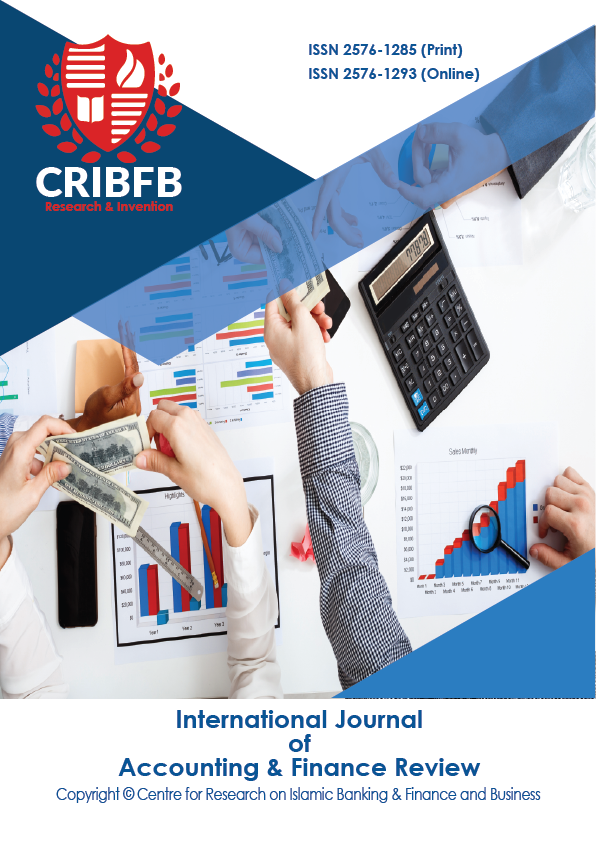MACROECONOMIC NEWS, AND MANAGEMENT FORECAST
Main Article Content
Abstract
Do companies whose earnings move more with macroeconomy more likely or less likely to offer management forecasts? This paper documents the following findings: (1) there is a significantly positive relationship between the extent to which a company’s earnings move in concert with GDP and the likelihood of issuing management forecasts. The explanation is that, if a firm’s earnings move in concert with GDP, then the cost of missing management forecasts is lower as managers could blame this on the wrong forecasts of macro news, instead of firm-specific forecasts. It contributes to the burgeoning literature on macro-accounting by first documenting this channel. Also, on top of R-square, which has been used in the literature on macro-accounting, this paper suggests that the coefficient and p-value from the regressions of firms’ earnings on GDP, is useful in helping identify bellwether firms (firms with high macroeconomic information content or firms connected to many other firms in the economy).
JEL Classification Codes: B17, B22, E27.
Downloads
Article Details
Section
How to Cite
References
Anilowski, C., Feng, M., & Skinner, D. J. (2007). Does earnings guidance affect market returns? The nature and information content of aggregate earnings guidance. Journal of Accounting and Economics, 44(1-2), 36-63.
Aramonte, S. (2014). Macroeconomic uncertainty and the cross-section of option returns. Journal of Financial Markets, 21, 25-49. https://doi.org/10.1016/j.finmar.2014.06.001
Bates, T. W., Kahle, K. M., & Stulz, R. M. (2009). Why do US firms hold so much more cash than they used to?. The journal of finance, 64(5), 1985-2021. Retrieved from https://onlinelibrary.wiley.com/doi/epdf/10.1111/j.1540-6261.2009.01492.x
Bidabad, B. (2019). Fluctuations and Business Cycles Prevention by New Financial Instruments and Banking Structure Reform. International Journal of Accounting & Finance Review, 4(1), 35-50. https://doi.org/10.46281/ijafr.v4i1.282
Carabias, J. M. (2018). The real-time information content of macroeconomic news: implications for firm-level earnings expectations. Review of Accounting Studies, 23(1), 136-166.
Collins, D. W., & Nguyen, N. Q. (2022). Aggregate accounting research and development expenditures and the prediction of real gross domestic product. Journal of Accounting and Public Policy, 41(1), 106901. https://doi.org/10.1016/j.jaccpubpol.2021.106901
Dye, R. A. (1985). Disclosure of nonproprietary information. Journal of Accounting Research, 23(1), 123-145.
Dye, R. A. (1986). Proprietary and nonproprietary disclosures. Journal of Business, 59(2), 331-366.
Feng, M., & Koch, A. S. (2010). Once bitten, twice shy: The relation between outcomes of earnings guidance and management guidance strategy. The Accounting Review, 85(6), 1951-1984.
Goodman, T. H., Neamtiu, M., Shroff, N., & White, H. D. (2014). Management forecast quality and capital investment decisions. The Accounting Review, 89(1), 331-365.
Hugon, A., Kumar, A., & Lin, A. P. (2016). Analysts, macroeconomic news, and the benefit of active in-house economists. The Accounting Review, 91(2), 513-534.
Hutton, A. P., Lee, L. F., & Shu, S. Z. (2012). Do managers always know better? The relative accuracy of management and analyst forecasts. Journal of Accounting Research, 50(5), 1217-1244. Retrieved from https://ideas.repec.org/a/bla/joares/v50y2012i5p1217-1244.html
Jung, W. O., & Kwon, Y. K. (1988). Disclosure when the market is unsure of information endowment of managers. Journal of Accounting Research, 26(1), 146-153.
Konchitchki, Y. (2011). Inflation and nominal financial reporting: implications for performance and stock prices. The Accounting Review, 86(3), 1045-1085. https://doi.org/10.2308/accr.00000044
Konchitchki, Y., & Patatoukas, P. N. (2014a). Accounting earnings and gross domestic product. Journal of Accounting and Economics, 57(1), 76-88. https://doi.org/10.1016/j.jacceco.2013.10.001
Konchitchki, Y., & Patatoukas, P. N. (2014b). Taking the pulse of the real economy using financial statement analysis: Implications for macro forecasting and stock valuation. The Accounting Review, 89(2), 669-694. https://doi.org/10.2308/accr-50632
Konchitchki, Y., Luo, Y., Ma, M. L., & Wu, F. (2016). Accounting-based downside risk, cost of capital, and the macroeconomy. Review of Accounting Studies, 21(1), 1-36.
Kothari, S. P., Shu, S., & Wysocki, P. D. (2009). Do managers withhold bad news?. Journal of Accounting research, 47(1), 241-276. https://doi.org/10.1111/j.1475-679X.2008.00318.x
Lamont, O. A., & Stein, J. C. (2006). Investor sentiment and corporate finance: Micro and macro. American Economic Review, 96(2), 147-151. https://doi.org/10.1257/000282806777212143
Li, N., Richardson, S., & Tuna, İ. (2014). Macro to micro: Country exposures, firm fundamentals and stock returns. Journal of Accounting and Economics, 58(1), 1-20. https://doi.org/10.1016/j.jacceco.2014.04.005
Skinner, D. J. (1994). Why firms voluntarily disclose bad news. Journal of Accounting Research, 32(1), 38-60.
Tseng. (2016). Investors’ Demand for Disclosures: The Case of Bellwether Firms, Working paper, Indiana University




